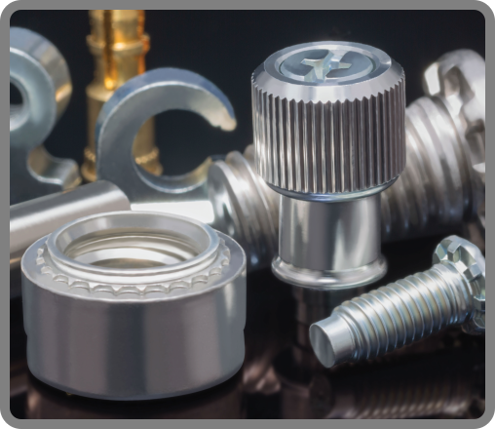
By Michelle Froese, Editor, Fastener Engineering
With a workshop of sorts set up in his garage, K.A. Swanstrom developed a revolutionary product in the early 1940s — one that would reduce time, labor, weight, and inventory on many assembly jobs. This new self-clinching fastener was easy-to-install and provided load-carrying threads in the metal sheets that are too thin to be tapped.
In 1942, Swanstrom officially founded PennEngineering & Manufacturing Corp., which today is a global company that manufactures a variety of mechanically attached fastening solutions. “The way I understand it is that our company founder began making weld nuts in his garage and slowly integrated this process into clinch nuts, which offer a different way to connect the nut to a piece of sheet metal. He then turned that idea into the worldwide business that we have today,” shares Brian Bentrim, VP, PEM New Product Development and Product Engineering, with Penn Engineering.
Based in Pennsylvania, Swanstrom worked as the president of Elastic Stop Nut Corporation, when he left to form PennEngineering.

Brian Bentrim, VP, PEM New Product Development and Product Engineering, with Penn Engineering
“When he was looking to move from his garage to a bigger space for the company, Swanstrom was in the Doylestown area. Apparently, he started driving out of town, following these three-phase wires that were attached to telephone poles and secure electricity on the side of the road,” says Bentrim.
Telephone poles either have a pair of wires at end of their T-shape or a third wire that sits on the top of that ‘T.’
PEM brand fasteners use self-clinching, broaching, flaring, surface-mount, or weld technology to provide strong, reusable, and permanent threads and mounting points in sheet metal, P.C. board materials, and other ductile or non-ductile thin material.
“The ones with the three wires allow more power to carry across the electrical connection, which is often needed for heavy equipment,” he explains. “Essentially, Swanstrom followed these connections until he found a plot of land for sale beside the three-phase wires. Our corporate headquarters, with now larger production facilities, are still in the same location.”

PennEngineering’s Danboro, PA headquarters
Swanstrom’s self-clinching fastener proved extremely successful at the time and its technology is still commonly used today. As the need to hold ultra-thin and ultra-light metals together grew, particularly in the electronics industry, so did the product line. Over the years, the original design has been modified to meet hundreds of new applications.
“At first, an electrical current was used to melt the nut and form a weld in the fastener. But then, Swanstrom realized that it was possible to design a geometric shape within the fastener and push it against the sheet metal, which would cause the sheet metal to flow and permanently deform against the nut,” says Bentrim.
By using this application, it was possible to lock the nut onto the sheet metal.
“Technically, the clinch nut was our first innovative product but second product line. The weld nut would have been the first product line,” he says. PEM, the company’s leading brand, has been recognized as the premier product in the thin sheet fastening industry for more than 75 years. “And since then, we’ve developed hundreds of innovative product lines. We continually look for different ways to solve problems in fastening and joining.”
“In my experience, nothing motivates engineers to push a project more than if it’s one of their ideas and something they want to run with, develop, and prove.”
One example of that innovation, according to Bentrim, is the R’ANGLE clinch fastener, which offers strong, right-angle attachment points in sheet metal or PC Boards. It uses the same technology as the clinch nut but instead of placing the nut directly against the sheet metal, it places it 90 degrees to the sheet metal.
“The R’ANGLE has a very PennEngineering, iconic shape to it and is used to mount a second sheet perpendicular to the first sheet,” he says. The benefits include tighter design control, material savings, fewer assembly steps, and a reduction of loose hardware. PennEngineering is a major supplier to the electronics and consumer electronics industries. However, it also serves the automotive, transportation, agriculture, construction equipment, special industry machinery, marine, alternative energy sectors, HVAC, and others — and almost anywhere in the world. The company is also continually working to improve these industries with advanced fastening solutions.
“We often ask ourselves: what are the problems that are being faced today in fastening and how can we better address those?” he says. “It’s ideal when a customer comes to us with a problem to solve but, to be honest, we’re always doing our own teardowns of equipment in an attempt to stay current on the different technologies and applications used…and to figure out if we can offer something better.”
Better could mean fewer parts, less costly parts, or an easier assembly method. Case-in-point: several years ago, one of the PennEngineering teams took apart a keyboard.
“Immediately, we noticed all of these tiny micro-screws that were maybe 1.6-millimeter-diameter threads. Each one had a locking patch with near-microscopic drivers on. So, when we went to take these hundreds of screws out, most of them refused to budge,” Bentrim explains. “They were permanently locked in.”
The team immediately began brainstorming. “It got us thinking: why use screws if you only ever intend to assemble the product and never disassemble it?” As a result, they developed a new fastener that was intended for permanent use.
“Instead of drilling a hole that was tapped and then requiring a screw that had a patch on it with a big head and a driver, we just pushed it in a simple little tack pin, which eventually became the microPEM TackPin. It had a shorter head and worked in a shallower hole, which led to a stronger hold and a smaller footprint.”
According to Bentrim, it was also less costly, faster, and easier to install. His team took the disassembled keyboard to the OEM to show them the new fastening option.
“They didn’t say too much at first but about 18 months later, they called us back and asked to take another look. Since then, we’ve sold billions if not hundreds of billions of these fasteners,” he says.
PennEngineering was able to increase the strength and reduce the thickness of these keyboards. And keyboards are not the only product with a similar setup. Yet, the most common way of putting something together is a screw.
“We continuously see people putting together products that are never intended to be disassembled…meaning that if it breaks, you’re likely going to replace and not repair it. This includes the sub-components of a computer or a car stereo. Very few people will try to repair the actual sub-component because it’s cheaper or easier just to replace them,” he says.
However, as Bentrim points out, there’s a lot that goes into the fastening of a screw. It requires a nut or a threaded hole, which then needs to engage and turn together. Torque is also often important to control.
“If you don’t need to take it apart, there’s a simpler way to achieve that joint. You don’t need a screw,” he points out. “But generally, this is the last thing on a person’s mind when they’re designing an application. However, it’s what we do and do well.”
Bentrim says one of the best parts about working at PennEngineering is the freedom and flexibility to try new ideas and create new solutions.
“In my experience, nothing motivates engineers to push a project more than if it’s one of their ideas and something they want to try to run with, develop, and prove. I allow my team as much flexibility as possible to think creatively and test out their ideas.”
This is particularly true from an R&D perspective, adds Bentrim.
“People typically don’t think of fasteners as all that interesting or exciting. But fasteners enable all of those exciting, smart, and sexy gadgets by holding them together,” he says. “By pushing the boundaries of what you can do with a fastener…well, that makes this job a lot of fun.”